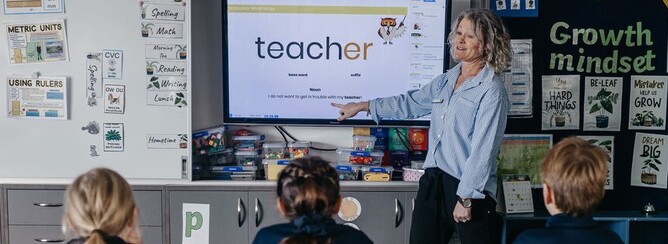Aotearoa New Zealand is on the cusp of a literacy revolution. As we lead into the first rollout of Y0–3 structured literacy professional learning and development, I have observed mixed emotions right across the sector.
I personally have had moments of immense excitement, disappointment, and moments of what I am going to call fear.
For the last nine and a half years I have dedicated most of my waking hours to working in this space. I have spent hours learning, leading, influencing, advocating, reflecting and at times backtracking or changing tack. I am not going to deny that this has been the most challenging decade of my life. On the cusp of turning the big 5-0 I am proud of the difference our dedicated, knowledgeable, and incredibly passionate team at Learning MATTERS has made. Our work has made a difference alongside others in this space, such as Liz Kane, Lifting Literacy Aotearoa, to name a few.
Today though, I am feeling a little trepidation. That trepidation has set in due to the fact that:
this is moving so fast
we cannot afford to get this wrong
our teachers deserve low-prep, high-outcome teaching environments
we are unclear what the complete commitment from Government and Ministry looks like across the tiers of instruction.
So how do we turn that around and what could this revolution look like if we get it right?
Fast paced – we can all handle a fast pace if we are considered in our actions. Taking time to build our knowledge, to reach out to the experts in this space, to talk to our colleagues, and to be upfront with when it is all a bit much and we need to just pause and rest our weary minds.
For those of us who have taught or parented a child or children with learning differences there is so much at risk. Many of us have witnessed over the past few years the true impact a structured literacy approach makes when implemented with fidelity. Therein lies the key. In my experience I have seen many variations of implementation – some successful and some not so. There is an immense amount of knowledge and practice improvements to be made (for all of us) when we move into implementation with fidelity and in line with the principles and elements as set out by the International Dyslexia Association (IDA). This then leads me to the next point…
Teachers not only deserve, but need to be supported with professional learning and associated resourcing that can result in low-prep, high-outcome teaching and learning. In my experience, this is a key factor in assisting them in making the greatest gains in their knowledge and practice. So often I hear talk of curating approaches around a pick’n’mix approach of resources, and scope and sequences. I am going to up front about this. Let’s face it, I have been for the last nine-and-a-half years, so why would I back down now just as we are on the cusp of the revolution.
STOP, just STOP, and consider this: the fundamentals of a structured literacy approach are that it will be diagnostic, systematic and cumulative, and explicit. This must be very carefully and strategically curated. We cannot make it up as we go. When implementing a change in practice we need structure, we need guidelines, and we need maximum support to get us going. We may not stick with those supports forever, but to get us started having a systematic and strategic structure and associated supports for implementation will lead to greater outcomes for teachers. Getting our teachers off the rank in a strategic and well-supported way will lead to greater and faster outcomes. Just like with our students, this builds confidence, reduces their cognitive load, and fills them with a sense of success. This was why we got into education!
In my experience we can fast-track our knowledge building and practice improvements to escalate student outcomes, BUT this must be strategic; it must be well-planned with a clear roadmap providing direction assisting you as a teacher or leader to ease your cognitive load. In my experience, this makes all the difference. This is one of the reasons why I founded iDeaL, a structured literacy platform that enables teachers to not only experience low-prep, high-outcomes but to become skilled in this. DELIVERY is the deal breaker. So, whatever we do as we walk into this revolution, we should consider how we are positioning ourselves to improve our INSTRUCTION and the systems that support this. The outcome we are looking for is quality implementation, low variance teaching between classes, low-prep, high-outcome teaching environments, increased student outcomes, and greater job satisfaction.
So, I ask you this: how are you feeling about walking into this literacy revolution? Are you feeling nervous, happy, confident, well supported? Check in with yourself and your team around this. Ask yourself/s what matters to you the most.
I am guessing it will be all centred around:
building greater knowledge and shared understandings yourself and among your colleagues and school community
being equipped with knowledge, quality practice, and an appropriate (range of) resources and systems to ensure this implementation is manageable, sustainable, and impactful for ALL moving forward
developing an understanding as to how you can implement an aligned structured literacy approach both in the classroom and in learning support
how your implementation will lead to earlier identification of literacy challenges and certainty that no child will fall through the crack, so to speak, due to the systems and processes you have in place
being able to monitor the impact of your implementation through the likes of an implementation matrix, quality assessment tools, reporting systems, and structures.
ensuring that teacher wellbeing remains at the heart of your implementation. This can be achieved with a commitment to a low-prep and high-outcome model where resourcing allows.
I have popped links to recent chit chats I had with incredible school leaders. They’ve been implementing structured literacy for some time and had some great insights to share.
Let’s position ourselves as best we can; let’s wrap the best systems, supports, and structures around ourselves and our teachers. As I sign off, it’s safe to say the feeling of excitement has resurfaced. YAH! It’s going to be a good one and we can do it in style – we have been for some time.
Some of Aotearoa’s leaders who have been walking towards the revolution for some time…
Abby, Chris, and Deborah: click here to view chit chat
Paula and Nik: click here to view chit chat
Tim, Andrea, and Megan: click here to view chit chat







